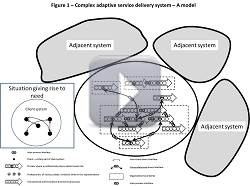6.1 – Understanding and managing processes
This is a conceptual video. It explains and illustrates the systems view of processes, value creation, process control, and the all-important learning loops using a few simple examples. Consider driving a car as a system. The driver gets feedback from the internal and external components. He processes this information and decides to make adjustments such as breaking, accelerating, deactivating the cruise control, turning up the air conditioner, and switching gears. The feedback he gets may lag the actual event that he is now noticing (the following car is really close) and it may take a while for the corrective action to take place (such as a decision time – i.e. change lane – and the time required to make it happen). He may also getting leading information of a traffic jam 5 kilometers down the highway and take appropriate steps to adjust for it by anticipation.
These notions, as well as the voice of the customer and learning loops are also presented using climate control in a house (see Section 6.2 and Figure 6.5). The video then shows how these notions can be transferred to a business context using the example of a pharmacy, previously presented in Figure 3.9 and Box 6.2. This last example allows for some further discussion of the linkages, presented in Chapter 5, between strategy and processes.
Key concepts: External environment, internal environment, feedback & control, feedforward control, voice of customer, lead and lag, learning loop, strategy-process connection
6.2 – Measuring and learning
“If you can’t measure it, you don’t know anything about it” used to say W. Edward Deming. “If it matters, it has to be observable and detectable. If it is detectable, it can be detected as an amount or range of amounts” adds D.W. Hubbard. Let’s not find what is easily measured, let’s explore in depth the phenomenon of interest (e.g. assurance, empathy, satisfaction) and find a way to measure it.
Key concepts: validity, repeatability, reproducibility, variation, precision, accuracy, interlinking, voice of customer, voice of process, measuring the right thing right. Examples include the history of the measurement of longitude, toast color, taste, courtesy on the phone, and Japanese Sushi restaurant.
6.3 – Supply chain – complex service version
Consider the following service episode: a person suffering from knee pain consults a physiotherapist at a nearby clinic. Dissatisfied with results after several sessions, he decides to seek the counsel of a general practitioner at a medical clinic, who injects cortisone to no avail. The general practitioner therefore refers him to an orthopaedist at a local hospital. The orthopaedist requests situation-specific images produced under the direction of a radiologist at another clinic. At the time of the next visit with the orthopaedist, the person and the physician agree to surgery which is later performed at a specialized hospital by a resident under the supervision of another orthopaedist. Physiotherapy treatments are subsequently prescribed and performed at the hospital. Home exercises are also prescribed but never carried out. After a certain time, still dissatisfied with results, the patient is treated successively by a chiropractor, physiatrist, physiotherapy technician (as opposed to professional) and acupuncturist before concluding that the situation is unlikely to improve and giving up. The above sequence includes eight different processes ranging from physiotherapy at a local clinic to examination by a general practitioner and subsequent action. The sequence of services is shaped by a combination of patient decisions, professional advice received, intra- and inter-organizational connections, and rules governing the transfer from one professional to another. Another patient with the exact same symptoms may well follow a totally different sequence and obtain radically different results. The “supply chain” is quite a different notion in complex services.
Key concepts: Service episode, client system, professional system, complex service delivery system, complexity science, power, irreducible uncertainty, control and emergence. Several examples used in other videos are revisited here to highlight the specificity of supply chains in complex services.


